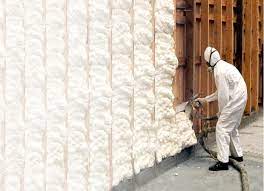If you’re looking for a way to keep your home cozy during the winter and cool in the summer, you might want to consider spray foam insulation. Unlike traditional insulation materials like fiberglass or cellulose, spray foam insulation fills every nook and cranny of the space it is applied to, creating an air-tight seal that prevents air leakage and heat loss. This can result in significant energy savings for homeowners, improved indoor air quality, and increased comfort.
So, if you’re considering spray foam insulation for your home or business, it’s important to understand the facts about this popular insulation material. This article will explain everything you need to know about spray foam insulation, from how it works to its benefits and drawbacks. So let’s get started!
What is Spray Foam Insulation?
Spray foam insulation is a modern solution to insulating your home or building. It is a type of insulation sprayed onto surfaces to create an airtight seal and provide thermal insulation. The foam comprises a mixture of chemicals that react when sprayed, expanding to fill gaps and create a solid, insulating barrier. Spray foam insulation for steel building is long lasting. It is commonly used in residential and commercial buildings to improve energy efficiency and reduce heating and cooling costs.
Are there different types of Spray Foam Insulation?
Yes, there are different types of spray foam insulation. The two main types are open and closed-cell spray foam insulation.
Open-cell spray foam insulation has a lower density with a core density around 0.5 pounds per cubic foot. This allows air to fill the open spaces within the material, making it a good sound absorber. Open-cell foam is also more flexible and can expand and contract with the building materials applied, making it a good choice for walls and ceilings.
Closed-cell spray foam insulation has a higher density and a more rigid texture because its cells are completely closed. This makes it more resistant to moisture and air infiltration, making it ideal for applications with tight air barriers, such as roofs, foundations, and exterior walls. The closed-cell foam also has a higher R-value per inch than open-cell foam, providing better thermal insulation.
Another difference between open-cell and closed-cell spray foam insulation is their cost. Closed-cell foam is generally more expensive than open-cell foam. Still, it may be a better choice for certain applications because of its higher insulation value and superior air-sealing properties.
Spray Foam Insulation advantages
Air-sealing properties: Spray foam insulation forms a tight seal that helps prevent air leaks and infiltration. This can help improve indoor air quality, reduce noise pollution, and prevent moisture from entering the building envelope, which can help prevent mold growth and other moisture-related issues.
Long-lasting: Spray foam insulation is durable and can last for the lifetime of your home or building without needing to be replaced or refreshed.
Eco-friendly: Spray foam insulation can help reduce energy consumption and greenhouse gas emissions, making it a more environmentally-friendly choice than traditional insulation materials.
Superior insulation performance: Spray foam insulation has a high R-value per inch, providing better thermal insulation and can help reduce energy bills.
Durability: It can last for the lifetime of a building, and it can help improve the strength and rigidity of the structure.
Versatility: Spray foam insulation can be used in various applications, including walls, roofs, and floors. It can also be used in new construction or retrofit projects and applied to irregularly shaped spaces and hard-to-reach areas.
Spray Foam Insulation disadvantages
Installation complexity: Spray foam insulation requires specialized equipment and trained professionals to install it correctly. Improper installation can result in poor insulation performance, air leaks, or moisture problems.
Health hazards: Spray foam insulation can emit volatile organic compounds (VOCs) during installation, which can cause respiratory issues.
Hard to remove or modify: Once spray foam insulation is installed, removing or modifying it can be difficult and costly. This can be a problem if changes are needed in the future, such as adding wiring or plumbing.
Higher cost: Spray foam insulation can be more expensive than other insulation materials, such as fiberglass or cellulose. This might make it a less attractive option for some building owners or homeowners, especially for larger projects.
Is Spray Foam Insulation Safe to Have in My Home?
Yes, spray foam insulation can be safe in your home if installed properly and in accordance with the manufacturer’s guidelines. However, proper ventilation is also vital during and after installation to help remove any lingering fumes or odors.








